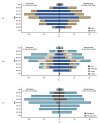Patient Characteristics and Clinical Course of COVID-19 Patients Treated at a German Tertiary Center during the First and Second Waves in the Year 2020
- PMID: 34073928
- PMCID: PMC8197386
- DOI: 10.3390/jcm10112274
Patient Characteristics and Clinical Course of COVID-19 Patients Treated at a German Tertiary Center during the First and Second Waves in the Year 2020
Abstract
In this study, we directly compared coronavirus disease 2019 (COVID-19) patients hospitalized during the first (27 February-28 July 2020) and second (29 July-31 December 2020) wave of the pandemic at a large tertiary center in northern Germany. Patients who presented during the first (n = 174) and second (n = 331) wave did not differ in age (median [IQR], 59 years [46, 71] vs. 58 years [42, 73]; p = 0.82) or age-adjusted Charlson Comorbidity Index (median [IQR], 2 [1, 4] vs. 2 [0, 4]; p = 0.50). During the second wave, a higher proportion of patients were treated as outpatients (11% [n = 20] vs. 20% [n = 67]), fewer patients were admitted to the intensive care unit (43% [n = 75] vs. 29% [n = 96]), and duration of hospitalization was significantly shorter (median days [IQR], 14 [8, 34] vs. 11 [5, 19]; p < 0.001). However, in-hospital mortality was high throughout the pandemic and did not differ between the two periods (16% [n = 27] vs. 16% [n = 54]; p = 0.89). While novel treatment strategies and increased knowledge about the clinical management of COVID-19 may have resulted in a less severe disease course in some patients, in-hospital mortality remained unaltered at a high level. These findings highlight the unabated need for efforts to hamper severe acute respiratory syndrome coronavirus type 2 (SARS-CoV-2) transmission, to increase vaccination coverage, and to develop novel treatment strategies to prevent mortality and decrease morbidity.
Keywords: COVID-19; SARS-CoV-2; first wave; hospital; mortality; patients; second wave; treatment.
Conflict of interest statement
A.N. declares that he received lecture honoraria and travel reimbursement over the past five years from CytoSorbents Europe, Biotest AG, and ThermoFisher Scientific. S.K. declares that he has received personal fees for lectures or consultancy and/or research support from Ambu, Astra Zeneca, Bard, Baxter, Bayer, Biotest, CytoSorbents, Daiichi Sankyo, E.T.ViewLtd, Fisher & Paykel, Fresenius Medical Care, Gilead, Mitsubishi Tanabe, MSD, Pfizer, Philips, Xenios, and Zoll. The authors declare they have no competing financial interest.
Figures



Similar articles
-
Comparison of characteristics, predictors and outcomes between the first and second COVID-19 waves in a tertiary care centre in Switzerland: an observational analysis.Swiss Med Wkly. 2021 Aug 10;151:w20569. doi: 10.4414/smw.2021.20569. eCollection 2021 Aug 2. Swiss Med Wkly. 2021. PMID: 34375985
-
Baseline Characteristics and Outcomes of 1591 Patients Infected With SARS-CoV-2 Admitted to ICUs of the Lombardy Region, Italy.JAMA. 2020 Apr 28;323(16):1574-1581. doi: 10.1001/jama.2020.5394. JAMA. 2020. PMID: 32250385 Free PMC article.
-
[Comparative study of patients hospitalized for SARS-CoV-2 infection in two consecutive waves in Tunisia].Med Trop Sante Int. 2022 Aug 18;2(3):mtsi.v2i3.2022.207. doi: 10.48327/mtsi.v2i3.2022.207. eCollection 2022 Sep 30. Med Trop Sante Int. 2022. PMID: 36284562 Free PMC article. French.
-
Changes in characteristics and outcomes of critically ill COVID-19 patients in Tyrol (Austria) over 1 year.Wien Klin Wochenschr. 2021 Dec;133(23-24):1237-1247. doi: 10.1007/s00508-021-01945-5. Epub 2021 Oct 18. Wien Klin Wochenschr. 2021. PMID: 34661740 Free PMC article.
-
Epidemiology, Clinical Profile, Intensive Care Needs and Outcome in Children with SARS-CoV-2 Infection Admitted to a Tertiary Hospital During the First and Second Waves of the COVID-19 Pandemic in India.Indian J Pediatr. 2023 Feb;90(2):131-138. doi: 10.1007/s12098-022-04283-0. Epub 2022 Aug 3. Indian J Pediatr. 2023. PMID: 35921029 Free PMC article.
Cited by
-
Sotrovimab in Hospitalized Patients with SARS-CoV-2 Omicron Variant Infection: a Propensity Score-Matched Retrospective Cohort Study.Microbiol Spectr. 2023 Feb 14;11(1):e0410322. doi: 10.1128/spectrum.04103-22. Epub 2022 Dec 8. Microbiol Spectr. 2023. PMID: 36475890 Free PMC article.
-
Changing trends of patient characteristics and treatment pathways during the COVID-19 pandemic: A cross-sectional analysis of 72,459 inpatient cases from the German Helios database.Front Public Health. 2022 Nov 7;10:1028062. doi: 10.3389/fpubh.2022.1028062. eCollection 2022. Front Public Health. 2022. PMID: 36420010 Free PMC article.
-
Prediction of mortality and prioritisation to tertiary care using the 'OUR-ARCad' risk score gleaned from the second wave of COVID-19 pandemic-A retrospective cohort study from South India.PLoS One. 2025 Jan 24;20(1):e0312993. doi: 10.1371/journal.pone.0312993. eCollection 2025. PLoS One. 2025. PMID: 39854588 Free PMC article.
-
[COVID 19 - Hospital Admission in the First and Second Wave in Germany].Dtsch Med Wochenschr. 2023 Feb;148(4):e14-e20. doi: 10.1055/a-1951-0629. Epub 2022 Dec 19. Dtsch Med Wochenschr. 2023. PMID: 36535644 Free PMC article. German.
-
Patients with COPD hospitalized due to COVID-19 in Spain: a comparison between the first and second wave.Rev Clin Esp (Barc). 2023 May;223(5):298-309. doi: 10.1016/j.rceng.2023.04.002. Epub 2023 Apr 5. Rev Clin Esp (Barc). 2023. PMID: 37028707 Free PMC article.
References
-
- WHO Director-General’s Opening Remarks at the Media Briefing on COVID-19—11 March 2020. [(accessed on 23 April 2021)]; Available online: https://www.who.int/director-general/speeches/detail/who-director-genera....
-
- Pfefferle S., Günther T., Kobbe R., Czech-Sioli M., Nörz D., Santer R., Oh J., Kluge S., Oestereich L., Peldschus K., et al. SARS Coronavirus-2 variant tracing within the first Coronavirus Disease 19 clusters in northern Germany. Clin. Microbiol. Infect. 2021;27:130.e5–130.e8. doi: 10.1016/j.cmi.2020.09.034. - DOI - PMC - PubMed
-
- Coronavirus Disease 2019 (COVID-19) Daily Situation Report of the Robert Koch Institute 10/04/2020—Updated Status for Germany. [(accessed on 23 April 2021)]; Available online: https://www.rki.de/DE/Content/InfAZ/N/Neuartiges_Coronavirus/Situationsb....
-
- Coronavirus Disease 2019 (COVID-19) Daily Situation Report of the Robert Koch Institute. 31/12/2020—Updated Status for Germany. [(accessed on 23 April 2021)]; Available online: https://www.rki.de/DE/Content/InfAZ/N/Neuartiges_Coronavirus/Situationsb....
LinkOut - more resources
Full Text Sources
Miscellaneous

